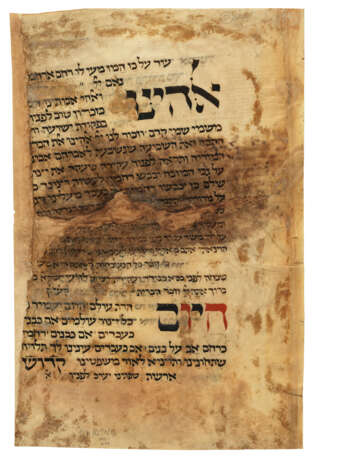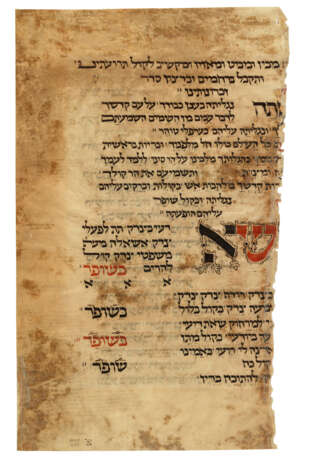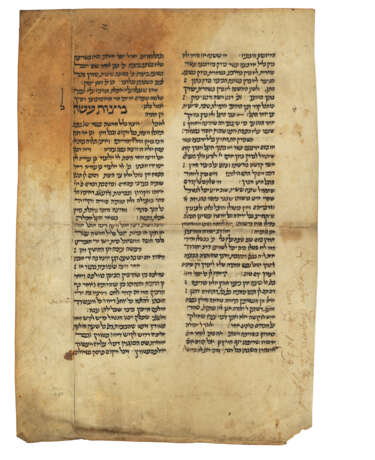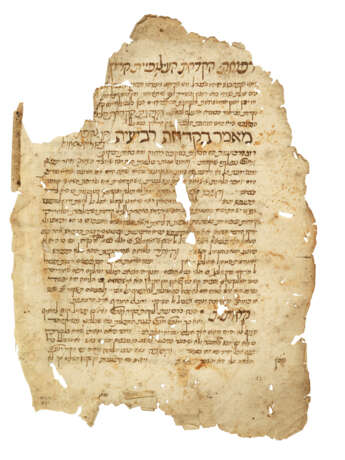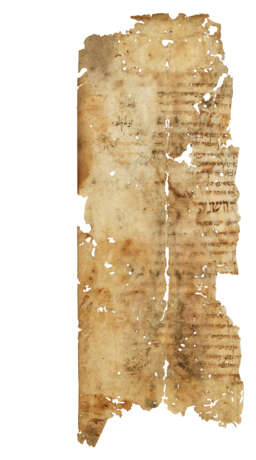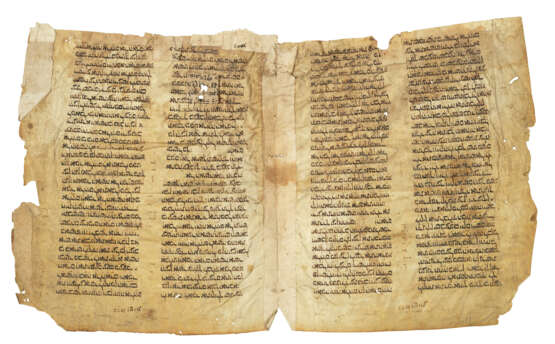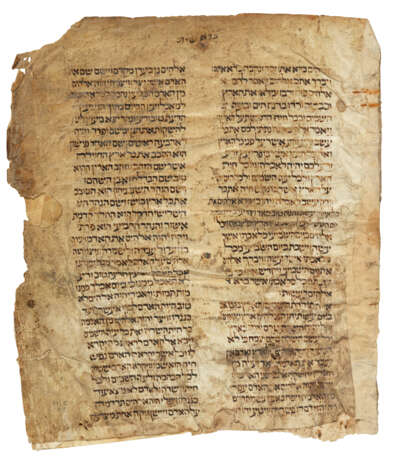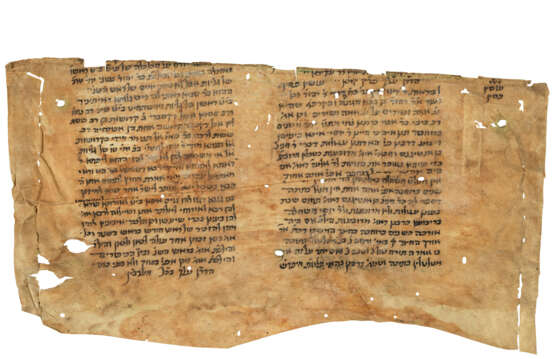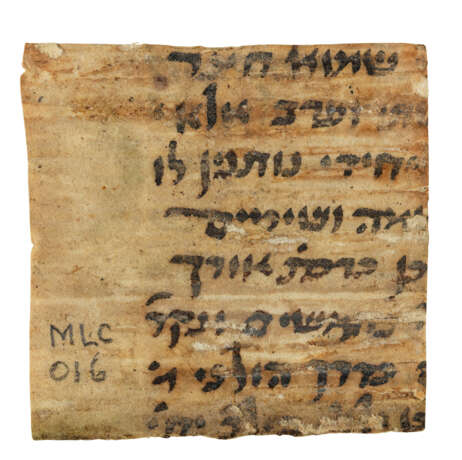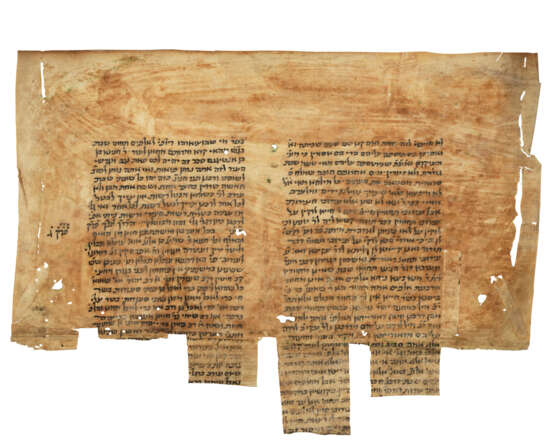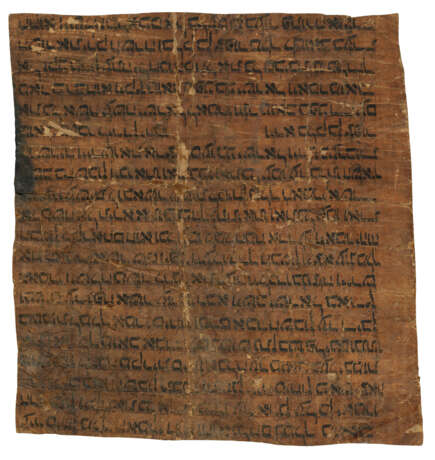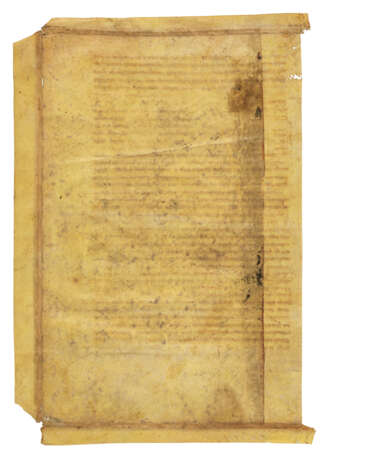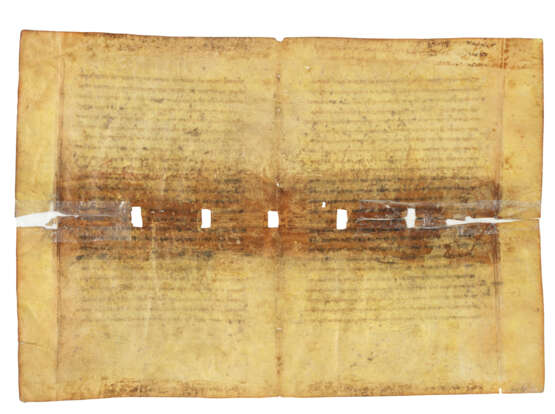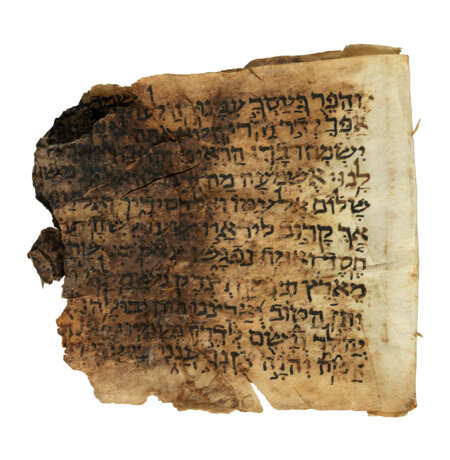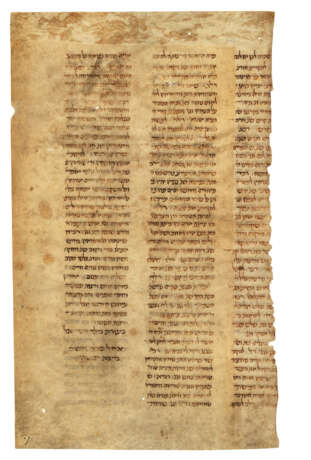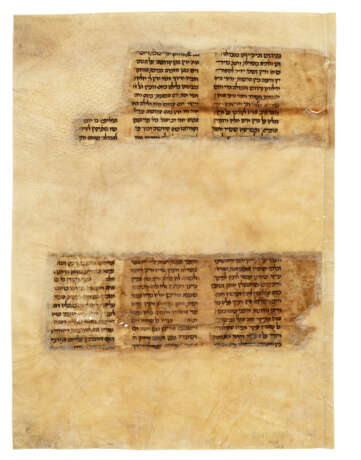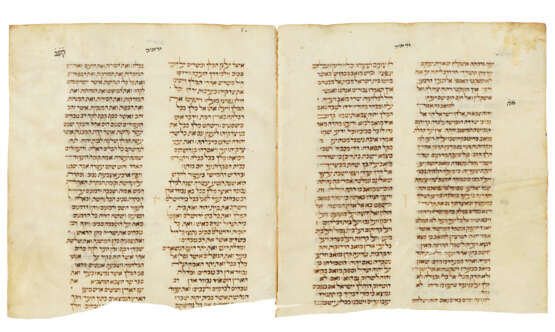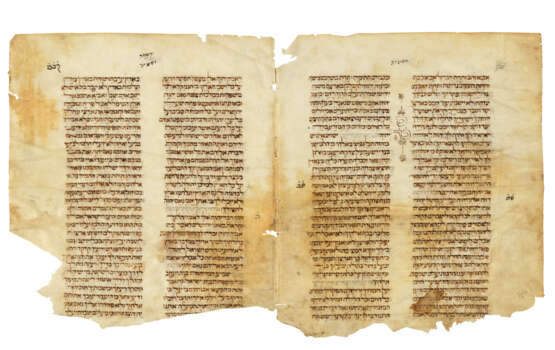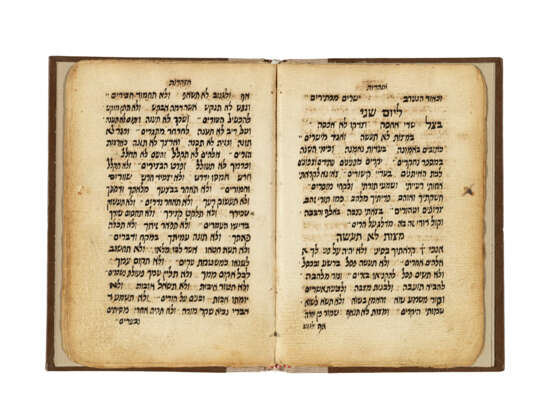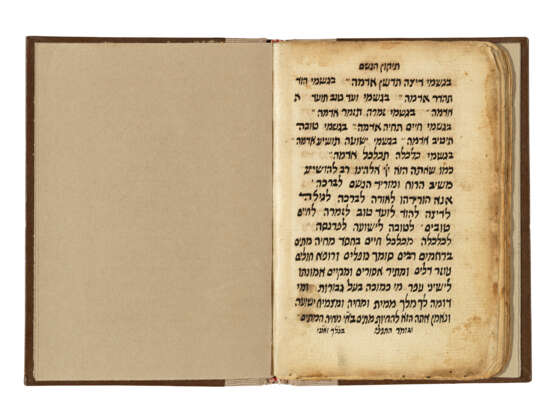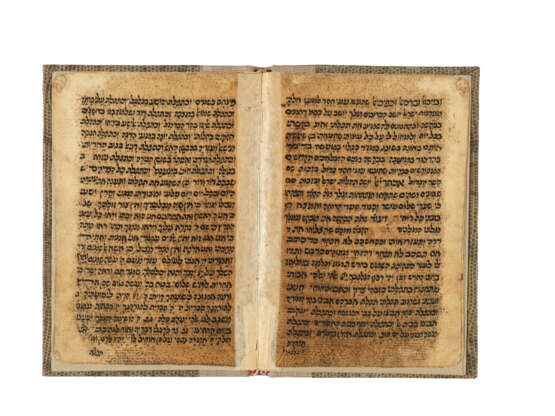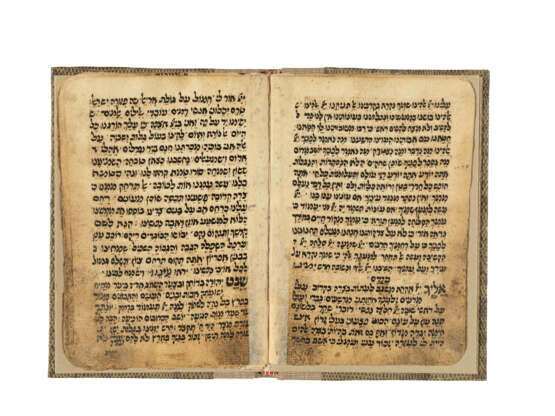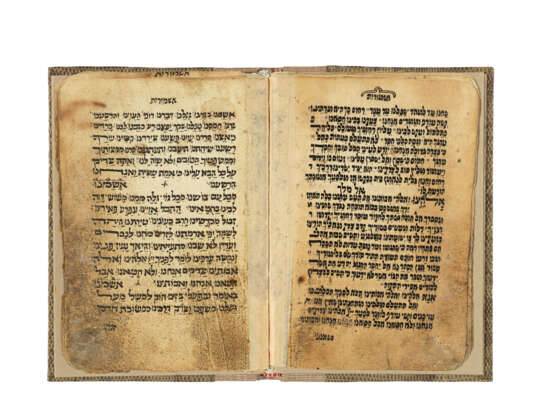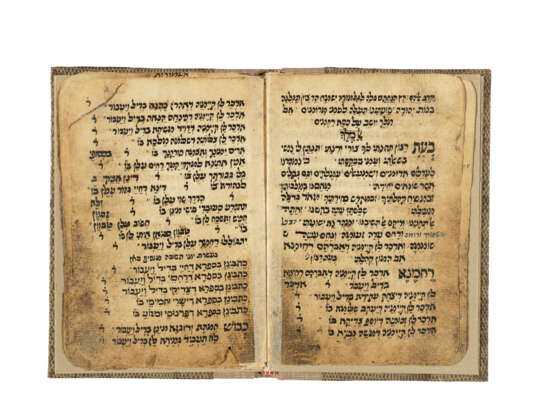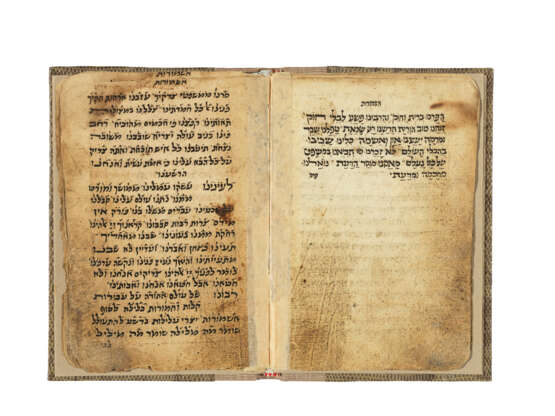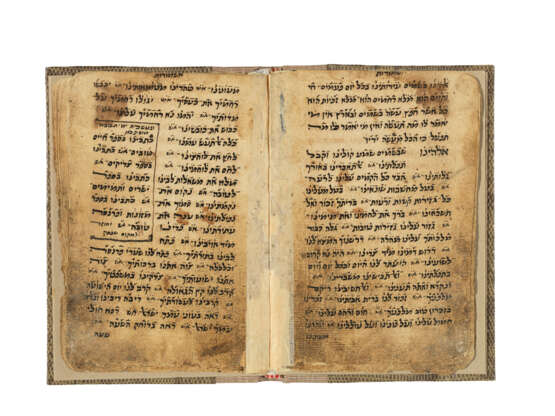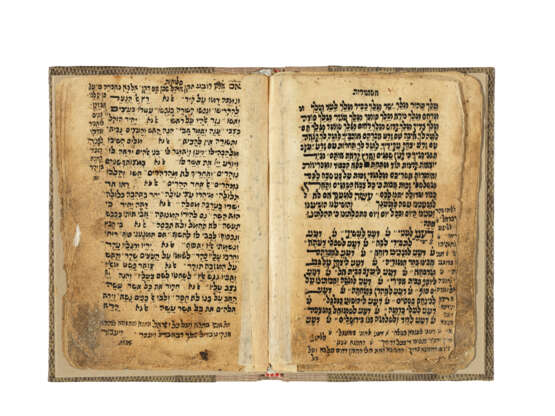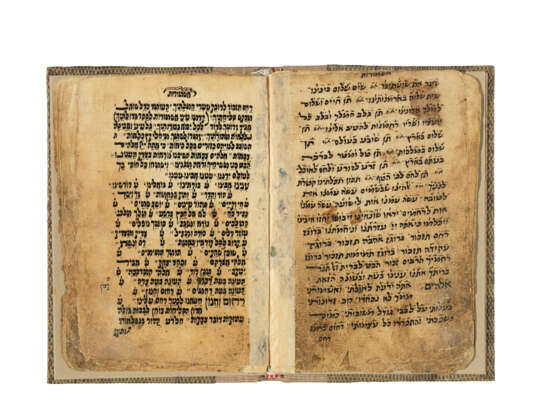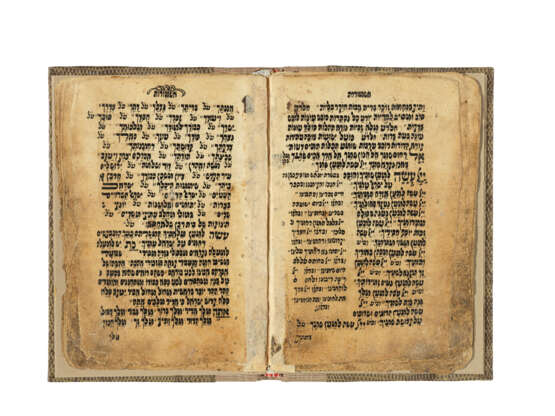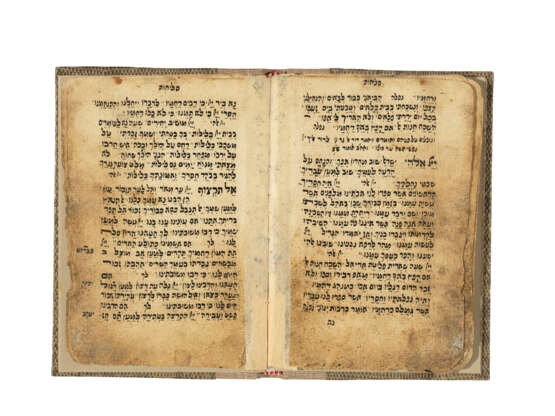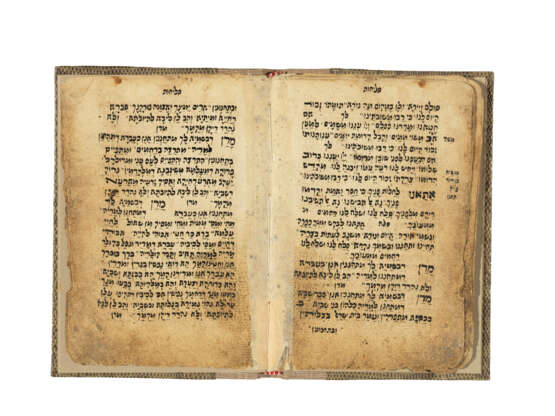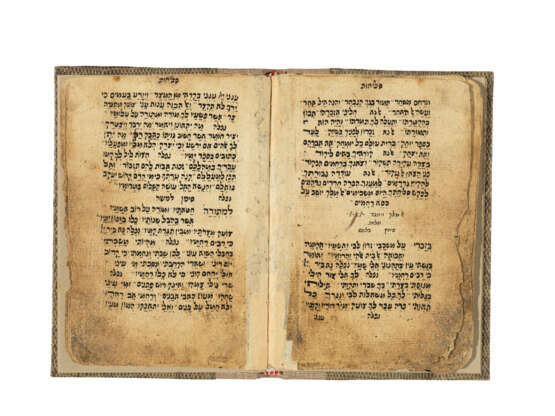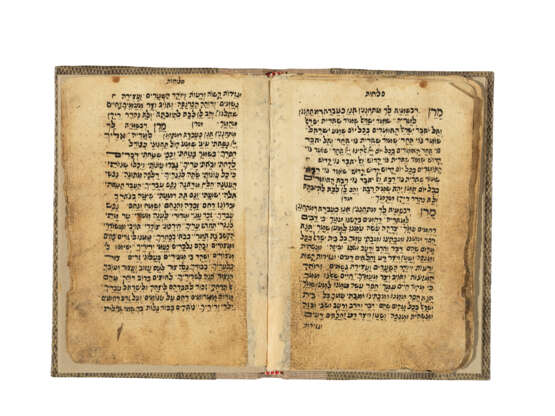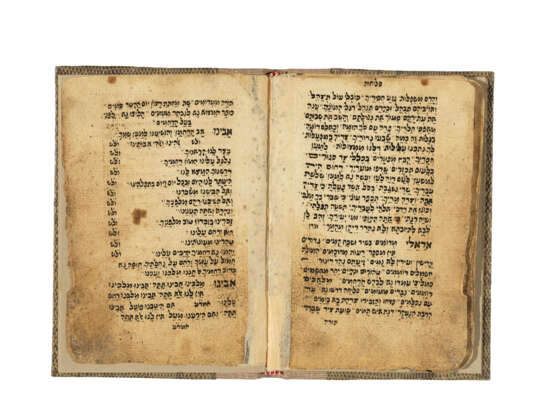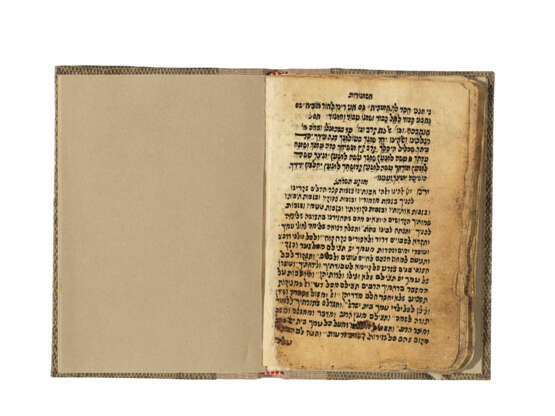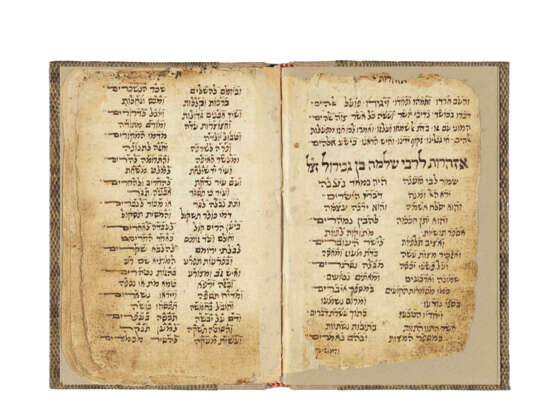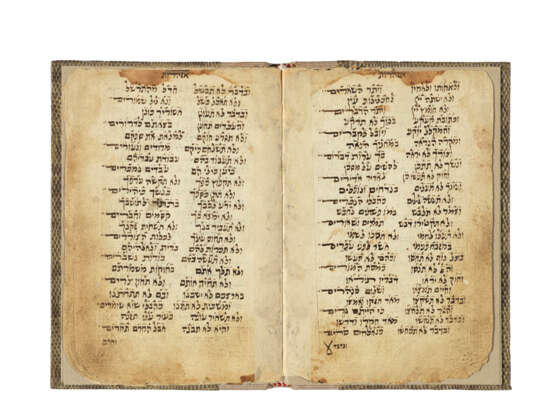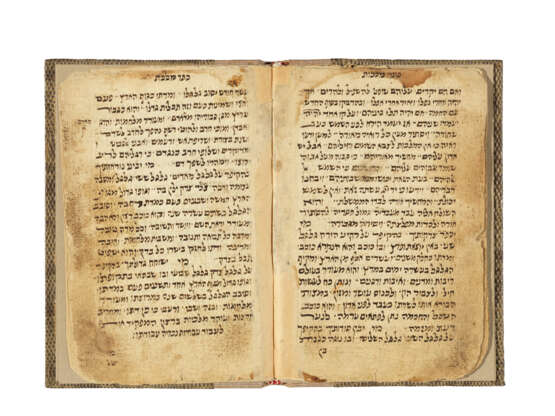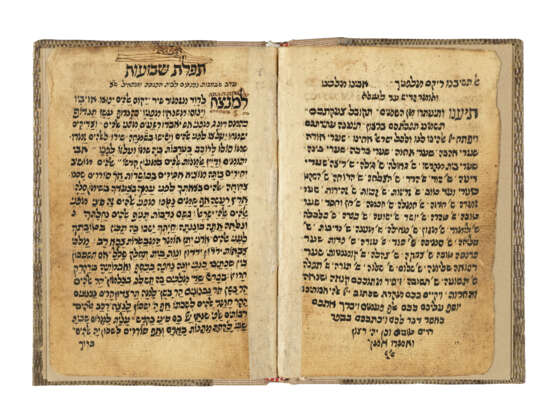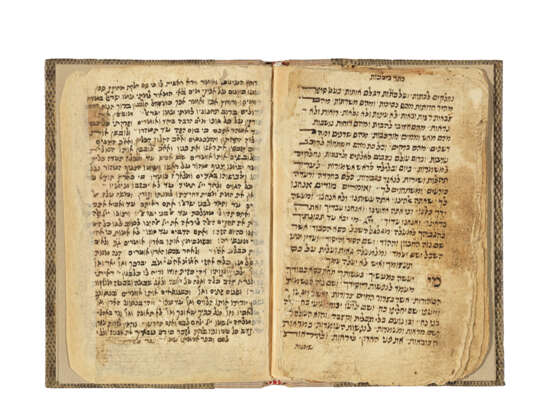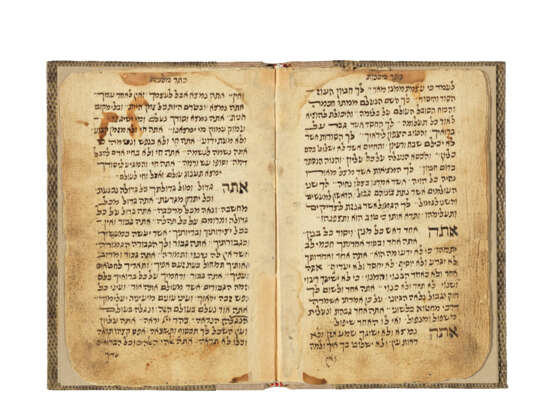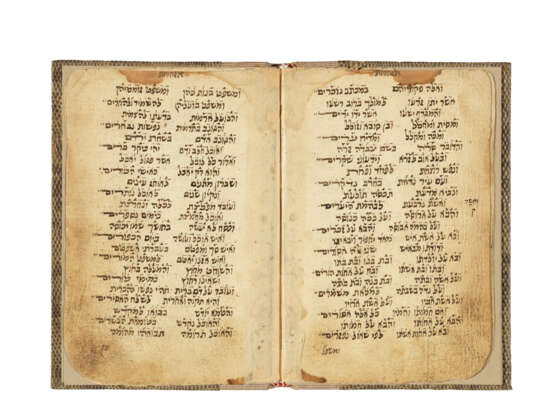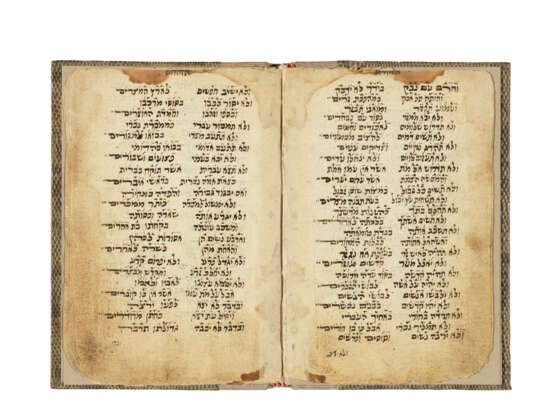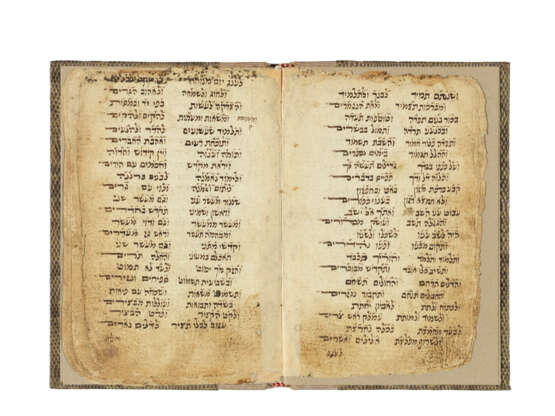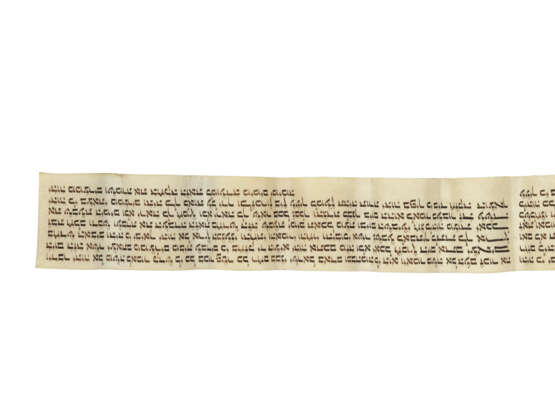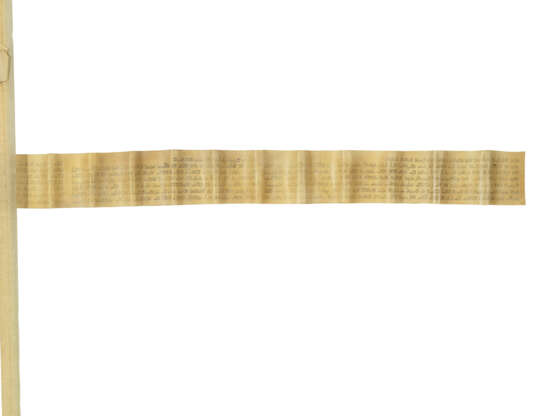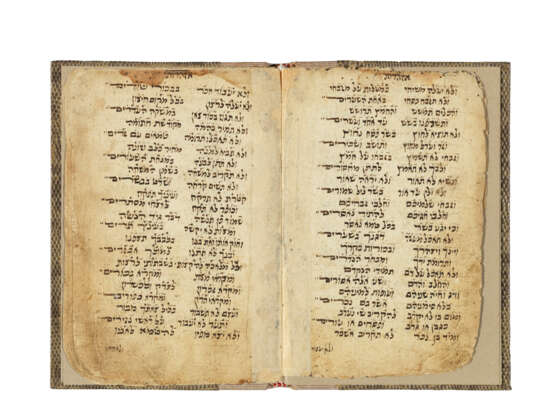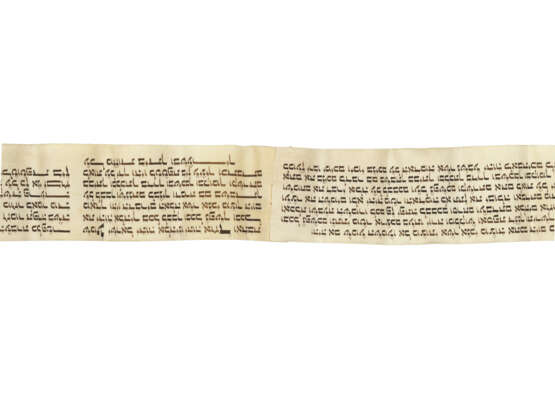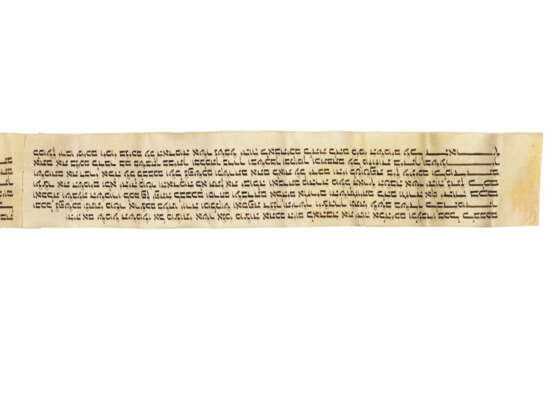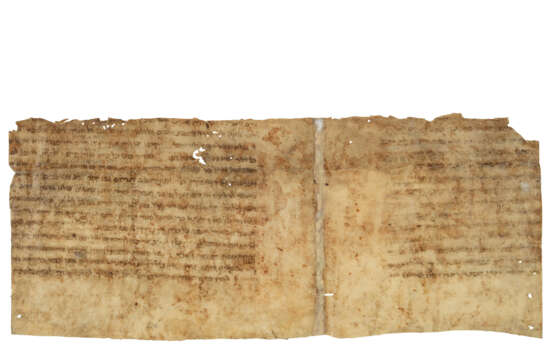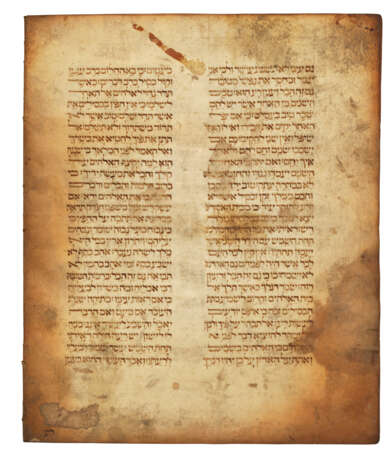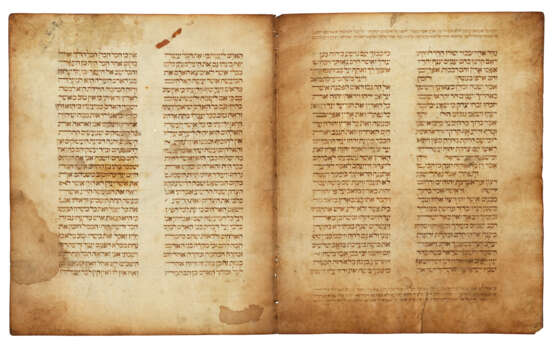ID 869547
Los 140 | A Judaica group
Schätzwert
£ 8 000 – 12 000
A collection of leaves and fragments, in Hebrew [Mid-East and Europe, 10th to 18th centuries]
An eclectic collection of fragments and leaves from Hebrew texts, ranging from the 10th to the 18th centuries.
(i) Book of Esther, an entire scroll, in Hebrew [Persia, 18th century].
c.135 × 2400mm.
Provenance: Colker MS O5; acquired from Bineth Galleries, Jerusalem in 1963.
(ii) Two leaves from a Bible (Genesis), in Hebrew, manuscript on vellum [Spain, 15th century].
Each leaf c.210 × 188mm. In a letter to Colker of 12 December 1980, Dr Israel Ta-Shema of the Jewish National and University Library writes that Prof. Malachi Beit-Arié of the National Library ascribed MLC O8 and O9 to Spain or North Africa, 15th century.
Provenance: Colker MS O8; acquired from Maggs in 1973.
(iii) Six leaves from a Bible (Prophets), in Hebrew, manuscript on vellum [Spain, c.1300].
c.258 × 195mm, with two of the bifolia c.220mm in height. Modern foliation and running headers. The manuscript can be compared to Paris, BnF, Hébreu 26, localised to Toledo and datable to 1272.
Provenance: Colker MS O9; each bifolium acquired individually from Maggs between 1973-1978.
(iv) - (viii) Five prayer books, incomplete, [Mid-East, 17th - 18th centuries].
(iv) c.155 × 105mm; (v) c.150-60 × 95-105mm; (vi) c.164 × 113mm; (vii) c.154 × 109mm; (viii) c.156 × 108mm.
Provenance: Colker MS O10-O14; acquired from Kaniel, Jerusalem in 1976.
(ix) Fragments from a Bible (Numbers 31; 40-32.10) with Targum Onkelos and Massora Parva glosses, in Hebrew and Aramaic, manuscript on vellum [Germany, 13th century].
c.190 × 290mm.
Provenance: Colker MS O15; acquired from B.M. Rosenthal in 1977.
(x) Three fragments from Alfasi, Sepher ha-Halakhot (Eruvin), in Hebrew, manuscript on paper [France or Germany, c.1300].
c.200 × 340mm. 180 × 340mm. 48 × 48mm.
Provenance: Colker MS O16; acquired from B.M. Rosenthal in 1977.
(xi) Part of a scroll from a Bible (Numbers), in Hebrew [Germany, 17th century].
c.195 × 180mm.
Provenance: Colker MS O19; acquired from B.M. Rosenthal in 1978.
(xii) Record of Births in a Yemenite family, 1892-1935, in Hebrew, manuscript on paper [Yemen, 19th-20th century].
177 × c.116mm.
Provenance: Colker MS O20; acquired from Kaniel, in Jerusalem in 1979.
(xiii) Talmud (Eruvin), in Hebrew, manuscript on vellum [France or Germany, 13th century].
c.281 × 123mm.
Provenance: Colker MS O21; acquired from Maggs in 1980.
(xiv) Four leaves and 2 fragments from Mordecai Ben Hillel, Sepher Mordecai, in Hebrew, manuscript on vellum [France or Germay, 14th century].
Each bifolium measures c.148 × 356mm, with fragments of c.167 × 53mm.
Provenance: (1) according to Colker, it served in the binding of an Italian mathematics manuscript (17th century), from which MLC 355 was also derived; (2) Colker MS O22; acquired from Maggs in 1984.
(xv) Compendium of Judaic thought, in Hebrew [Italy, 15th century].
c.293 × 205mm. Content in three parts: (1) on biblical commandments, (2) chronological list of events in Judaic history; (3) list of biblical prophets.
Provenance: Colker MS O23; acquired from Quaritch in 1984.
(xvi) Rashi, Commentary on Talmud (Berakhot), in Hebrew [Franco-German, 15th century]
c.280 × 205mm.
Provenance: Colker MS O24; acquired from Quaritch in 1984.
(xvii) Two leaves from Rashi, Commentary on Book of Numbers, in Hebrew [Spain, 15th century].
The bifolium measures c.130 × 368mm.
Provenance: Colker MS O25; acquired from Quaritch in 1984.
(xviii) Two leaves from Abraham Ibn Ezra, Commentary on Exodus, in Hebrew [Italy, 14th century].
c.240 × 341mm.
Provenance: Colker MS O26; acquired from Quaritch in 1985.
(xix) Two leaves and two fragments from the Book of Psalms, in Hebrew, manuscript on vellum [Syria or Iraq, 10th century].
c.95 × 157mm.
Provenance: (1) Otto Ege (1888-1951), who described it as 'One of the earliest medieval Hebrew manuscripts'. (2) Colker MS O28; acquired from B. Hoffman, London in 1986.
(xx) Two fragments from a Mahzor (Shavuot), in Hebrew, manuscript on vellum [Germany, 14th or 15th century].
Each fragment c.145 × 223mm.
Provenance: (1) 'Biblia presens conuentui columbariensi [i.e. Colmar] ordinis predicatorum pertinet / concessa fratri anthonio pistori predicti ordinis [...] in prefato conuentu / celebratur capitulum quod fuit anno domini 1484 / [...] et tunc temporis prior ut supra'; (2) 'ffrater anselmus hassolt / prior huius domi olim / anno 1555'; (3) Colker MS O29; acquired from B. Hoffman, London in 1986.
(xxi) Four leaves and three fragments from a text on Medicine, in Hebrew, manuscript on paper [Spain or North Africa, late 15th or 16th century].
Each leaf c.280 × 205mm. Fragments measure c. 280 × 60mm, c.280 × 105mm, c.90 × 60mm.
Provenance: Colker MS O31; acquired from B. Hoffman, London in 1987-1988.
(xxii) Bible (Judges) with Targum Onkelos and Masorah, in Hebrew, manuscript on vellum [Germany, 13th or 14th century]
c.370 × 248mm, with an additional 23mm turned up at the lower edge.
Provenance: (1) Used in an early modern binding ('Musica Herbst P. P.') of a copy of Johann Andeas Herbst, Musica Practica [and Musica Poetica?]; (2) Colker MS O32; acquired from Quaritch in 1989.
(xxiii) Tephillin, in Hebrew, manuscript on vellum [Bohemia-Moravia, c.1850]. With parchment case.
c.450 × 75mm (when folded)
Provenance: Colker MS O34; acquired from a bookshop in Prague in 1993.
(xxiv) Saadya Gaon, translation of Pentateuch into Arabic, manuscript on vellum [Yemen, 15th century].
c.275 × 188mm. The Hebrew beginning of each verse is followed by the translation of the full verse into Judeo-Arabic.
Provenance: Colker MS O36; acquired from Quaritch in 1995.
(xxv) A fragment from a Mahzor, with evidence of the Italian and Byzantine rites, in Hebrew and Aramaic [Italy, 14th century]. In correspondence with Colker, Yisrael Dubitsky (who calls this fragment 'of considerable interest') explains that the fact there is Aramaic targum to every verse of the Haftarah is indicative of the Italian rite. Furthermore, the line on the second page 'tefilat amusekha ki-temidei yom [...]' is found only in the Italian rite. Indicative of the Romaniote (Byzantine) rite is the poem at the bottom of the second page which begins '[Yah se'et oro] ve-hofia be-hod hadaro [...]'. Part of the text is for the Pesach.
Provenance: (1) 'Per suora Anna (Iustina?) Martha'; (2) 'Heredità di madalena marrochi; (3) Colker MS O39; acquired from B.M. Rosenthal in 1998.
(xxvi) Two leaves from Moses of Coucy, Sepher Mitzvot Gadol, in Hebrew, manuscript on vellum [Germany, 14th century].
c.298 × 183mm.The text represents the Mitzvot Aseh nos 39-41. The marginal note is an omission from the text.
Provenance: (1) Used as a wrapper for 'Register Inquezitionum für Hospitall von Jahr 1619'; (2) Colker MS O40; acquired from Maggs in 2000.
(xxvii) Two nearly complete leaves from a Mahzor, containing portions of the service for Rosh Hashanah, probably for a lectern, in Hebrew, manuscript on vellum [Germany, c.1300].
c.384 × 230mm.
Provenance: Colker MS O41; acquired from Quaritch in 2003.
(xxviii) Two partial leaves and two fragments from Isaac of Corbeil, Sepher Mitzvot Katan, in Hebrew, manuscript on vellum [Germany, c.1300].
c.85 × 240mm.
Provenance: Colker MS O42; acquired from Quaritch in 2003.
(xxix) A bifolium from a Bible (Deuteronomy and Ecclesiastes), with Masorah, in Hebrew, manuscript on vellum [Spain, 14th century].
Each leaf 289 × 237mm.
Provenance: Colker MS O43; acquired from James Stevens Cox (1910-1999).
(xxx) A fragment from a Mahzor (Shabbat Shekalim), probably for a lectern, in a Hebrew Ashkenazi hand, manuscript on paper [France or Germany, c.1300].
c.269 × 340mm. Represents poem by Rabbi Eleazar Kalir.
Provenance: Colker MS O44; acquired from the Dring collection.
| Kategorie des Auktionshauses: | Handschriften des Mittelalters und der Renaissance |
|---|
| Kategorie des Auktionshauses: | Handschriften des Mittelalters und der Renaissance |
|---|
| Adresse der Versteigerung |
CHRISTIE'S 8 King Street, St. James's SW1Y 6QT London Vereinigtes Königreich | |
|---|---|---|
| Vorschau |
| |
| Telefon | +44 (0)20 7839 9060 | |
| Aufgeld | see on Website | |
| Nutzungsbedingungen | Nutzungsbedingungen |
